BUSAN – A 3D horror movie set in a public toilet block is part of a revolution underway in the Asian film industry as low-budget 3D productions take on the big studios at their own game.
At the 16th Busan International Film Festival (BIFF), audiences have been lining up to see the likes of multi-million dollar 3D productions “The Three Musketeers” and the re-imaged version of the local monster hit “The Host”.
But there’s also been a groundswell of support for two debut features that use the same cutting edge digital technology to help entertain at a fraction of the price.
“Budget doesn’t matter, it is story that matters in cinema and it’s the same when you are using 3D,” said South Korean Choo Sang-rok, director of the 3D feature “Persimmon.”
Choo’s edgy horror movie, which had its world premiere at BIFF — Asia’s largest film festival, was shot on a budget of around US$2 million.
And while the James Cameron-directed extravaganza “Avatar” with an estimated budget of US$300 million may have awoken the world to what can be achieved with 3D technology, Choo has opted for a far more modest production.
For starters, the film is shot mostly inside a public toilet block.
“Persimmon” follows the fortunes of five people who become trapped inside the toilet block and are left at the mercy of the ghost who has lured them inside.
The director says it is based on a common urban myth in Korea and it was the confined space in which it is set that first made him think of using 3D.
“Technically, when you are working with 3D it is better to work in a deep and narrow space rather than a wide open space so it is a medium that suits this story,” said Choo.
“I think 3D, in my film, brings the audience into the film. It makes them feel what the actors feel. And you don’t need to have a big budget to do that. I wanted them to feel they were trapped in the bathroom with the actors.”
Choo believes advances in digital technology are expanding the filmmaking landscape for smaller productions as much as they are for the major blockbusters and that there is an audience out there for both.
“The biggest attraction is it takes you from movies you watch to movies you actually experience,” he said. “The spectators can actually participate in the movie as well.
“You don’t have to focus on the budget. You can focus on getting the audience involved in the movie and that’s why the future of low budget 3D movies is looking good.”
Veteran Chinese filmmaker Tsui Hark has also been in Busan to collect the Asian Filmmaker of the Year Award and he was quick to point out just how large the potential for 3D is in the region.
In the world’s fastest-growing movie market, with receipts rising by 61 percent to US$1.47 billion in 2010, China’s cinema owners have embraced the 3D revolution.
Tsui, currently working on the 3D feature “The Flying Swords of Dragon Gate”, told a press conference he estimated 4,000 of the nation’s 10,000 cinema screens were geared up to screen 3D films.
The IHS Screen Digest Cinema Intelligence report, released in August, said global 3D ticket sales soared to US$6.1 billion last year — up from US$2.5 billion in 2009.
That would have come as good news for South Korean director Park Hong-min. His debut 3D feature “A Fish” also made its world premiere at BIFF — and it is a low-key film that ended up costing him only US$100,000 to make.
The thriller, which follows a man’s search for the wife who has left him to become a shaman, uses the nuances of digital technology more than relying on any lavish, jaw-dropping effects.
“When I first started thinking about making a 3D film I thought about all the special effects but I wanted to use it to exaggerate what people are seeing in more normal situations and to then blur the lines between fantasy and reality,” said the director.
Park said 3D technology was a format more independent filmmakers were exploring, even though in the beginning they might have to work through a process of trial and error.
“At the moment, for small filmmakers, we don’t have a lot of knowledge about how 3D films are made,” said Park. “You have to figure it out for yourself. I spent nine months in post-production and I never really turned my computer off. I had to solve all the problems myself.
“But this is my first 3D feature so I knew I had to take everything on — and 3D is becoming more and more a part of the film medium.”
BIFF continues until Friday and closes with the announcement of its main New Currents award for Asian filmmakers, and with the world premiere of the drama “Chronicle of My Mother” by Japanese director Masato Harada.
